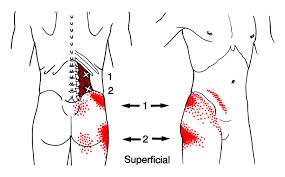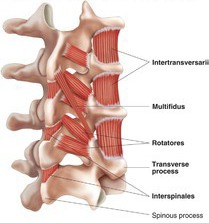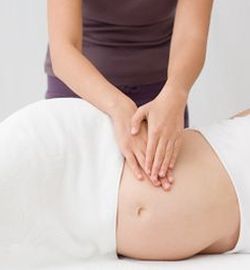Low back pain is a common problem that can range from occasional to debilitating pain. Some of the causes of low back pain include overexertion, overuse, postural issues, muscle imbalances, autoimmune disorders and degenerative changes in the spine. In all cases of low back pain that we see in our practice, there are abnormalities that have formed in the soft tissue around the spine. Many times, the proper treatment of the soft tissue brings 100% relief to the patient. In other cases, we are able to significantly reduce the pain, which gives the patient a better quality of life.
Erector Spinae Muscle Syndrome
 This large group of muscles runs along both sides of the spine and plays a significant role in our posture, working to keep us up right. When the left and right sides are in balance, these muscles help distribute vertical pressure evenly throughout the spine. However, when there is an imbalance between the two sides, pressure is spread unequally through the vertebrae, contributing to early degeneration of the discs.
This large group of muscles runs along both sides of the spine and plays a significant role in our posture, working to keep us up right. When the left and right sides are in balance, these muscles help distribute vertical pressure evenly throughout the spine. However, when there is an imbalance between the two sides, pressure is spread unequally through the vertebrae, contributing to early degeneration of the discs.
Active trigger points in these muscles cause pain that:
- Refers to the low back and sacrum
- May be mistaken for SI Joint Dysfunction
- Radiates into the buttocks
Additional symptoms:
- Pain is superficial when touching the low back
- Pain is worse in the morning
- Pain going from sitting to standing
- Pain and restriction bending forward and to the opposite side side
- Pain increases with physical activity that requires extension, lateral flexion or rotation of the spine
- Pain is less severe than with QL Muscle Syndrome (below)
Quadratus Lumborum Muscle Syndrome
The quadratus lumborum muscle also helps to keep us up right by extending the spine. It additionally provides lateral flexion and some rotation of the vertebral column. It is attached to the 12th rib, fixing it in place during inhalation.
When the QL muscle is in spasm, it can cause debilitating pain.
Active Trigger Points in this muscle can cause pain in:
- The low back
- The hip joint and groin
- The sacral area
- The buttocks
Additional symptoms:
- Any movement of the spine may cause pain
- Pain is worse in the morning
- Pain may increase with deep breathing, sneezing or coughing
- If the upper portion of the muscle irritates nerves at L2-L4, pain will be felt in the front, inside or outside of the thigh
- Compensatory scoliosis to the opposite side
- Elevated shoulder on the opposite side of the pain
Rotator Spinae Muscle Syndrome
The  rotator spinae muscle group include the multifidus muscles and rotatores. These small muscles span between 2 and 5 vertebrae help provide rotation of the spine to the opposite side.
rotator spinae muscle group include the multifidus muscles and rotatores. These small muscles span between 2 and 5 vertebrae help provide rotation of the spine to the opposite side.
When these muscles are in spasm, symptoms include:
- Pain with rotation or flexion of the spine to the opposite side
- Less pain when bending forward
- Pain that is less severe than with Erector Spinae Muscle Syndrome and more difficult to pinpoint




